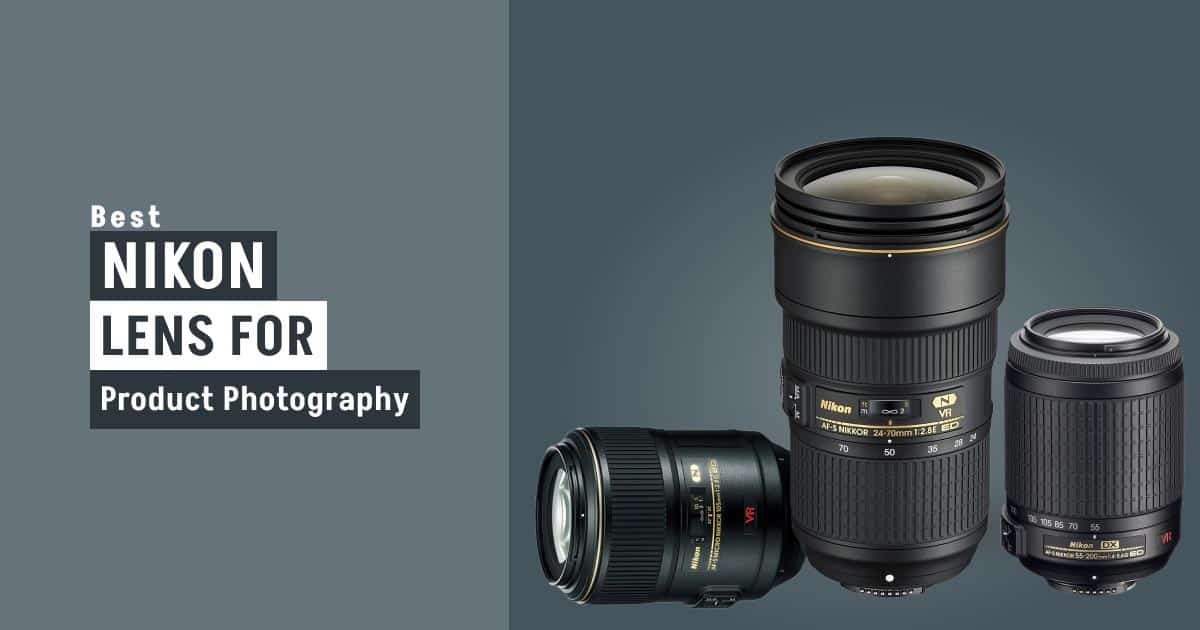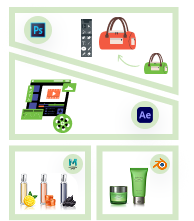The best lenses for product photography are feature-rich and allow for creative and professional captures of product images. Nikon has been launching and upgrading its series of lenses to capture picture-perfect images. Choosing a lens contributes to capturing products without flaws indoors or outdoors, capturing sharp and detailed shots, and ensuring product features and benefits are highlighted. Product photography demands clarity, accuracy, and distraction-free images. E-commerce product photographers use prime lenses, telephoto lenses, and macro lenses to take shots of products. The best Nikon lenses for product photography offer high-quality, sharp images, built-in image stabilization, accurate color representation, professional and focused look on the images. The best Nikon lenses for product photography include, Nikon Nikkor Z MC 105mm f/2.8 VR S, Nikon AF-S 50mm f/1.8G, Nikon AF-S 16-35mm f/4G ED VR, Nikon AF-S DX Micro-NIKKOR 40mm f/2.8G, Nikon Z 24-70mm f/4 S, Nikon AF-S FX NIKKOR 24-70mm f/2.8E ED, Nikon Z MC 50mm f/2.8, Nikon AF-S DX Micro Nikkor 85mm f/3.5G ED VR. Nikon AF-S NIKKOR 85mm f/1.8G, and Nikon AF-S VR Micro-NIKKOR 105mm f/2.8G IF-ED Lens. The 10 best Nikon lenses are as follows.
What you’ll learn in this article
- 1 1. Nikon Nikkor Z MC 105mm f/2.8 VR S
- 2 2. Nikon AF-S 50mm f/1.8G
- 3 3. Nikon AF-S 16-35mm f/4G ED VR
- 4 4. Nikon AF-S DX Micro-NIKKOR 40mm f/2.8G
- 5 5. Nikon Z 24-70mm f/4 S Lens
- 6 6. Nikon AF-S FX NIKKOR 24-70mm f/2.8E ED
- 7 7. Nikon Z MC 50mm f/2.8 Macro Lens
- 8 8. Nikon AF-S DX Micro Nikkor 85mm f/3.5G ED VR Lens
- 9 9. Nikon AF-S NIKKOR 85mm f/1.8G Lens
- 10 10. Nikon AF-S VR Micro-NIKKOR 105mm f/2.8G IF-ED Lens
- 11 What Types of Lenses Work Best for Product Photography?
- 12 Why is Choosing the Best Lens for Product Photography Important?
- 13 What Features to Consider While Choosing the Best Lens for Product Photography?
1. Nikon Nikkor Z MC 105mm f/2.8 VR S

Nikon Z MC 105mm is a professional-grade macro lens offering stunning detail and stabilization. Its 1:1 reproduction ratio allows photographers to capture intricate details, textures, engravings, and materials of any products, especially jewelry, cosmetics, electronics, and home appliances. The optical design of this S-line lens provides accurate, sharp, standard, and commercial-grade photography. The VR system works seamlessly with in-body image stabilization.
Specifications
- Lens Type: Telephoto
- Dimensions: 5.6 x 3.4 x 5.6 inches
- Lens Weight: 1.39 pounds
- Compatible Mounting: Nikon Z
- Format Compatibility: FX (full-frame), DX (crop sensor)
| Pros | Cons |
| High-quality and sharp images | Only mountable for the Nikon Z series |
| Weather sealing capability | |
| Fast autofocus | |
| Effective stabilization |
2. Nikon AF-S 50mm f/1.8G
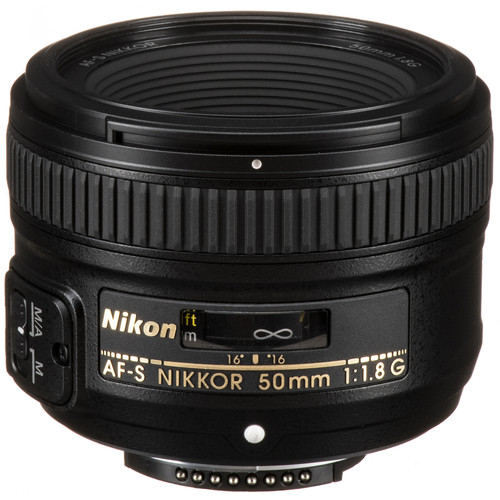
Nikon AF-S 50mm f/1.8G is a compact FX-format prime lens. It’s a modern take on the classic 50mm focal length, giving a standard-angle field of view with a full-frame body. This lens is versatile and can be used for a wide range of photography fashion photography, close-up jewelry photography, and macro product photography.
Specifications
- Lens Type: Standard
- Dimension: 2.09 x 2.83 x 2.83 inches
- Lens Weight: 6.5 ounces
- Compatible Mounting: Nikon F (FX)
- Format Compatibility: FX digital, DX digital, and 35mm film
| Pros | Cons |
| Very sharp and compact with a Fast aperture | No vibration reduction or aperture ring |
| Autofocus Performance and Accuracy | |
| Optimized for edge-to-edge sharpness on both FX and DX format DSLRs | |
| Smooth and pleasing bokeh |
3. Nikon AF-S 16-35mm f/4G ED VR
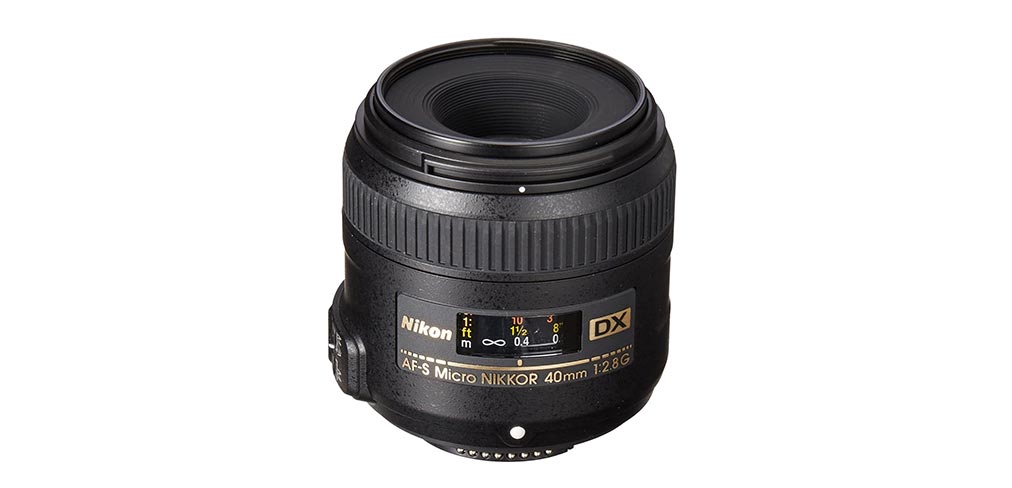
Nikon AF-S 16 is an ultra-wide-angle zoom lens that captures powerful pictures of products in a wide-angle view, flat lay shots, or of large products. Its specialty lies in shooting with minimal distortion. It’s built-in Vibration Reduction (VR II) ensures excellent stability during handheld shooting. The lens’s Silent Wave Motor (SWM) functions in fast, quiet shots while ensuring precise composition.
Specifications
- Lens Type: Wide Angle
- Dimension: 4.92 x 3.27 x 3.27 inches
- Lens Weight: 1.5 pounds
- Compatible Mounting: Nikon F (FX)
- Format Compatibility: Nikon’s FX-format (full-frame) DSLRs
| Pros | Cons |
| Produces sharp images | Produces barrel distortion |
| Handheld shooting at a slower shutter speed | |
| Dust and moisture sealing for outdoor shooting | |
| Maintains contrast even in strong lighting |
4. Nikon AF-S DX Micro-NIKKOR 40mm f/2.8G
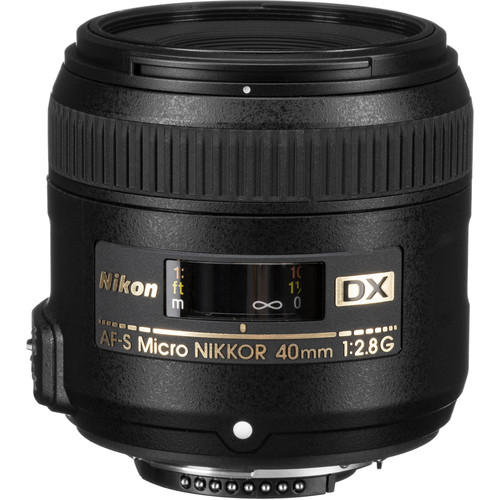
Nikon AF-S DX Micro-NIKKOR 40mm f/2.8G is a close-up lens for Nikon DSLR Cameras. It’s a compact and lightweight lens that gives high resolution and contrast from infinity to life-size to focus extra closely on the subject. It provides sharp images from infinity to life-size (1x), with autofocus to 64 inches.
Specifications
- Lens Type: Standard
- Dimension: 2.56 x 2.72 x 2.72 inches
- Lens Weight: 8.3 ounces
- Compatible Mounting: Nikon F (DX)
- Format Compatibility: DX-format (APS-C sensor)
| Pros | Cons |
| Sharp images in the center | Not ideal for full-frame |
| Isolates the subject from the background | |
| Portable and compact | |
| Minimal distortion |
5. Nikon Z 24-70mm f/4 S Lens
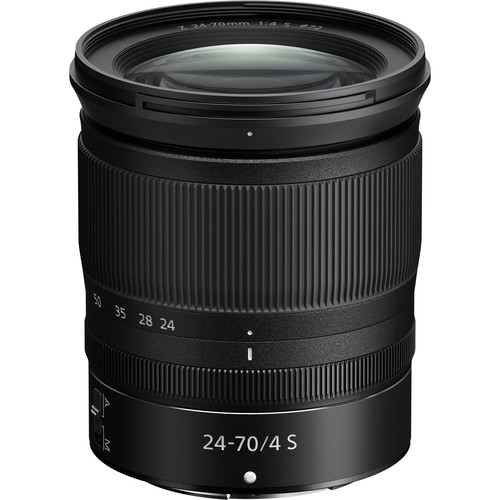
Nikon Z 24-70mm is a standard zoom lens that delivers sharp, high-contrast images. It is a compact build lightweight camera that offers consistent exposure and depth of control. The in-built technologies include ED, Nano Crystal, and Super Integrated Coatings, aspherical elements, fluorine-coated front elements that refrain from appearances of chromatic aberration, distortion, flare, and ghosting, resulting in color-accurate images.
Specifications
- Lens Type: Zoom
- Dimension: 3.5 x 3.1 x 3.1 inches
- Lens Weight: 1.1 pounds
- Compatible Mounting: Nikon Z
- Format Compatibility: FX (full-frame) and DX (APS-C crop sensor)
| Pros | Cons |
| Versatile zoom range | Awkward retractable design |
| Quick, quiet, and precise autofocus | |
| Minimal chromatic aberration | |
| Weather-sealed construction |
6. Nikon AF-S FX NIKKOR 24-70mm f/2.8E ED
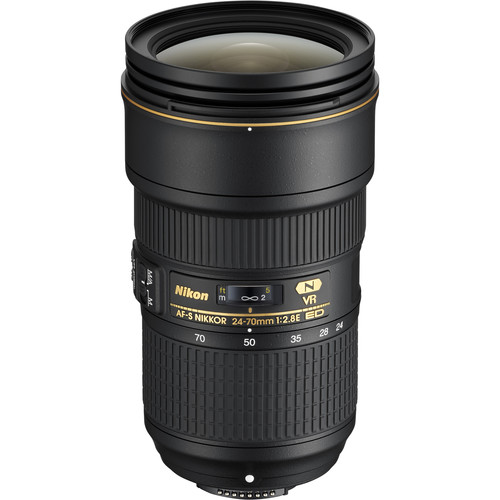
Nikon AF-S FX NIKKOR 24-70mm f/2.8E ED is a vibration-reduction zoom lens with autofocus for Nikon DSLR Cameras. It contains a fast f/2.8 constant aperture with an electromagnetic diaphragm. It has sensational image quality and sharpness with virtually no distortion.
Specifications
- Lens Type: Standard
- Dimension: 5.75 x 5.75 x 9.25 inches
- Lens Weight: 2.35 pounds
- Compatible Mounting: Nikon F
- Format Compatibility: Full-frame/FX-format, Full-frame/FX-format in APS-C size/DX-format Crop Mode, 35mm Film
| Pros | Cons |
| Sharp and edge-to-edge performance | One of Nikon’s pricey lenses |
| Fast and precise autofocus | Heavier and larger build |
| Enhanced quality image stabilization | |
| Smoothing zooming capabilities | |
| Versatile focal lengths |
7. Nikon Z MC 50mm f/2.8 Macro Lens

Nikon Z MC 500mm is a lightweight camera built for Nikon Z-mount mirrorless cameras. With the 1:1 magnification, it delivers crisp, sharp, and detailed images. The 50mm focal length provides natural perspective, perfect for capturing both close and wide product compositions. The lightweightness of the lens makes it perfect equipment to shoot tabletop photographs or handheld shots. To speed up focusing, the lens features a focusing limiter.
Specifications
- Lens Type: Macro 50mm
- Dimension: 2.6 x 74.5 x 74.5 inches
- Lens Weight: 9.1 ounces
- Compatible Mounting: Nikon Z
- Format Compatibility: FX-format Nikon Z-mount cameras, also with DX models.
| Pros | Cons |
| Detailed close-up shots | Short working distance at 1:2 magnification |
| Quiet and accurate autofocusing | |
| Precise control of aberrations and distortions | |
| Versatile use cases as a standard and macro lens |
8. Nikon AF-S DX Micro Nikkor 85mm f/3.5G ED VR Lens
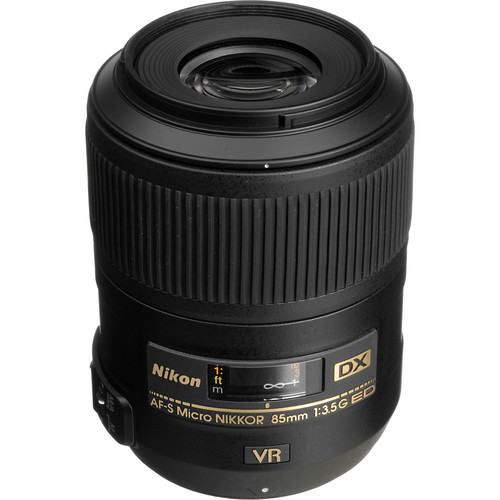
Nikon AF-S DX Micro Nikkor 85mm f/3.5G ED VR is a versatile medium-telephoto macro lens. It provides fantastic close-up macro portrait shooting with Vibration Reduction (VR). Its extra-low dispersion (ED) element provides superior sharpness and color correction.
Specifications
- Lens Type: Telephoto
- Dimension: 3.9 x 2.87 x 2.87 inches
- Lens Weight: 12.5 ounces
- Compatible Mounting: Nikon F (DX)
- Format Compatibility: Nikon DX-format (APS-C) DSLR cameras
| Pros | Cons |
| Captures very sharp images | DX-only design |
| Silent autofocus with full-time manual override | |
| Built-in VR to compensate for camera shake | |
| Reduced chromatic aberration |
9. Nikon AF-S NIKKOR 85mm f/1.8G Lens
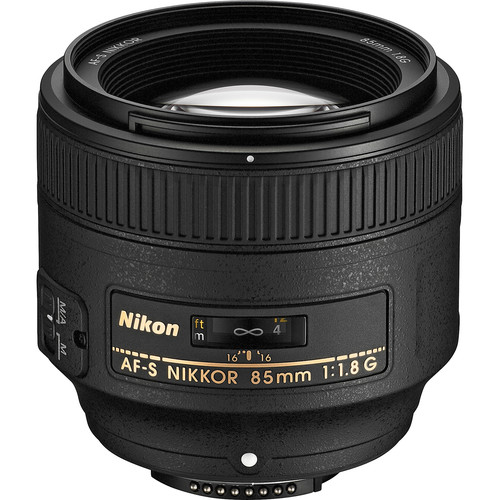
Nikon AF-S Nikkor 85mm is a fast and short telephoto prime lens featuring sharp optics, natural perspective, and a fast aperture. Though it is a portrait lens, its functionality and capability offer robust features for products, such as subject isolation, background blur, and lifestyle product images. Its f/1.8 maximum aperture successfully captures product shots in low light, ensuring a comfortable shooting experience for large product photography, food product photography, and cosmetics photography.
Specifications
- Lens Type: Telephoto
- Dimension: 2.87 x 3.15 x 3.15 inches
- Lens Weight:12.3 ounces
- Compatible Mounting: Nikon F (FX)
- Format Compatibility: Nikon F (FX)
| Pros | Cons |
| Lightweight and well-balanced | Vignetting at wide apertures |
| Powerful low-light performance | |
| Internal focusing allows filters | |
| Durable and weather-sealing capabilities |
10. Nikon AF-S VR Micro-NIKKOR 105mm f/2.8G IF-ED Lens

Nikon AF-S VR Micro-NIKKOR 105mm f/2.8G IF-ED Lens is designed for macro photography. This lens is sufficient for any virtual photographic situation. It has a new VR II vibration reduction technology, and it contains an internal focus to give fast and quiet auto-focusing.
Specifications
- Lens Type: Telephoto
- Dimension: 4.57 x 3.27 x 3.27 inches
- Lens Weight: 1.74 pounds
- Compatible Mounting: Nikon F (FX)
- Format Compatibility: FX (Full-Frame), DX (APS-C) 35mm film, and mirrorless camera.
| Pros | Cons |
| Offer a life-size reproduction | No focus limiter switch |
| Built-in image stabilization | |
| Internal focusing | |
| Solid build quality |
What Types of Lenses Work Best for Product Photography?
Prime lens, telephoto lens, and macro lens work best for product photography. However, the lens for product photography is the one with functional features and perfectly captures the product with sharp focus, the right color, and size accuracy within the frame. There is no one-size-fits-all lens that captures all products. Rather, photoshoot circumstances determine the types of cameras in action.
Prime Lens
A prime lens is a standard camera lens with a single focal length and no zoom-in or zoom-out option. It provides a specific angle of view based on the exact focal length of the lens. Choose a prime lens when you are shooting an indoor/studio environment, the product is in still condition, and you don’t need to move the focal length. You will get a sharper image.
Telephoto Lens
A telephoto lens is mainly used to make a subject appear closer than it is. It contains a focal length that is usually shorter than the physical length of the lens. There are usually two types of telephotos.
- Medium Telephoto, about 70 mm- 200 mm
- Super telephoto, about 300 mm
The lens is adaptable to different situations and allows changing the composition without physically changing the position of the product. Use a telephoto lens of 85mm or higher with a good lens speed for depth of field.
Macro Lenses
A macro lens is specifically used to take extremely close-up or detailed images, such as a detailed picture of an insect or a flower. It has a small minimum focusing distance, allowing the subject to appear more significant on the sensor.
Should I use a Macro Lens for Product Photography?
You should use a macro lens for product photography, but it depends. Using a macro lens for product photography when the subject is small and complex will give you the edge though.
Is a 24mm Lens Good for Product Photography?
A 24mm lens is a good lens for product photography while shooting large products, flat lay photography, or outdoor shots. However, it is not as reliable as it creates perspective distortion and composition complexity.
Why is Choosing the Best Lens for Product Photography Important?
Choosing the best lens for product photography is important for producing high-quality images. A 2024 study published in the Journal of Research in Interactive Marketing found that high-resolution photos in cause-related marketing posts on Instagram get more favorable brand evaluations and increased engagement, including sharing, compared to low-resolution images. A quality lens enhances photo quality and product presentation and minimizes distortion.
- For creating sharp and detailed images: A high-quality lens ensures steady focus and sharp images with professionalism. Products in the frame appear in detail with features, textures, and craftsmanship, which work as visual information to convince potential buyers.
- For enhancing product look: High-quality product photos convince potential buyers and get more engagement across social platforms. Having the right lens impacts getting market recognition and boosting sales during online competition.
- For real-life presentation: Professional quality lenses accurately display colors, minimizing viewers’ confusion. Also, professional product photographers minimize distortions, glare, or reflections by using the lens, resulting in clean and standard product photos, effective for an online catalog. Thus, products appearing in a professional and real look build customers’ trust.
- For controlling depth of field: A high-quality lens controls the visibility level of a product in focus. Narrow apertures keep the product in focus. Wide apertures capture the surrounding view, allowing for creativity such as blurry background, bokeh, etc.
- For presenting product versatility: Different products shine in different styles, frames, and focal lengths. Choosing the right camera allows you to capture shots in rthe ight focal lengths. A macro lens captures small and fine details, whereas a standard or wide-angle lens is perfect for shooting larger products or group shots.
Prime Lenses vs. Telephoto Lenses vs. Macro Lenses for Product Photography: What are the Differences Among Them?
The key differences among prime lenses, telephoto lenses, and macro lenses include their aperture, effectiveness, field of view, and construction.
| Criteria | Prime Lens | Telephoto Lens | Macro Lens |
|---|---|---|---|
| Identity | A prime lens has a fixed focal length, without zooming in/out options. | A telephoto lens has a longer focal length (usually 70 mm+), captures shots from a distance. | A macro lens has a close focusing focal length, 1:1 magnification, that captures shots from very close with fine detail. |
| Aperture | Wide maximum aperture | Narrower maximum apertures | Maximum apertures range between f/2.8 and f/3.5 |
| Effectiveness | For shooting in a controlled environment | For shooting larger products from a distance | For capturing products up close to a life-like size presentation |
| Field of view | Offers a natural and realistic view | Offers a narrow field of view | Offers a variety of fields of view. |
| Construction | Compact and lightweight | Large and heavy | Moderate size and weight. |
| Best to use | Medium-sized products, low-light situations, and blurry backgrounds. | Large products to shoot from away | Small products and capturing details. |
What Features to Consider While Choosing the Best Lens for Product Photography?
While choosing the best lens for product photography, consider focal lengths, minimum focusing distance, aperture, and depth of field of a lens.
1. Focal Length
Focal length is the calculation of the optical distance between the image sensor and the lens when you make an object in focus. It defines the angle of view—how much of the scene will be captured and determines the sizes of each component in the image (known as magnification). There is no specific rule for choosing focal lengths for a professional product photoshoot, but it needs lenses that can focus sharply at an aperture.
Using a 50-100 mm lens on a full-frame camera or a 35-60mm lens on a cropped-sensor camera will be best because it creates a natural look. However, lenses with a focal length smaller than 50mm can force you to deal with wide-angle distortion. So, it would be best if you avoided it.
2. Minimum Focusing Distance
Every lens contains a focusing distance limitation, a minimal distance from which the lens focuses on the product. If the distance between the camera and the item is smaller than the lens specification, it cannot catch focus properly. And you should move the camera away from the product. You have to manipulate the product if you cannot move the camera farther from your product, especially when using a fixed position. Otherwise, your lens will be useless to use.
3. Aperture
The aperture impacts how much light hits the image sensor of the lens. The aperture is mainly measured in f-stops and is stylized as f/2, f/4, f/8, and more. It defines how much light you let in and affects the depth of the field. To make engaging product photos, you should set the aperture between f/4.5 to f/7.1 while using a plain and white background for product photography. And you can also set f/2.8 or lower if you don’t use a white background.
4. Depth of Field
The depth of the field mainly varies according to the type of lens. There are 2 types of depth of field: Shallow depth of field and deep depth of field.
- A shallow depth of field is used to focus on a tiny portion of the photo frame.
- A deep depth of field is used to imply most of the photo frame.
To make your engaging and high-impact product photos, you should ensure that which depth of field depicts your product astonishingly.
